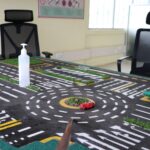Navigating the bustling roads of Nairobi, Mombasa, or Kisumu requires more than just confidence behind the wheel—it demands skill, knowledge, and preparation. For aspiring drivers in Kenya, the National Transport and Safety Authority (NTSA) driving exam is the gateway to earning a valid driving license. This comprehensive test evaluates both theoretical understanding and practical driving ability, ensuring that only competent drivers hit the road. With Kenya’s roads growing busier and the stakes for road safety higher than ever in 2025, passing the NTSA driving test is a critical milestone.
This article is your ultimate guide to acing the NTSA driving exam in Kenya. From mastering the theory test to navigating the practical exam and understanding the Model Town Board, we’ve compiled expert tips, common questions, and practical advice to help you succeed on your first attempt. Whether you’re a new driver or refreshing your skills, these insights will equip you to conquer the NTSA driving test with confidence.
Understanding the NTSA Driving Exam Process
The NTSA driving exam is a two-part process designed to ensure drivers are well-versed in Kenya’s traffic laws and capable of handling real-world driving scenarios. According to the NTSA, the exam assesses a candidate’s ability to drive safely without endangering other road users. The process includes:
- Theory Test: A written or computer-based exam covering the Kenya Highway Code, road signs, traffic rules, and safe driving practices.
- Practical Test: A hands-on assessment of your driving skills, including vehicle control, road awareness, and adherence to traffic regulations.
To pass, candidates must achieve at least an 80% score, combining performance in both sections. Preparation is key, as the test is known for its tricky questions and strict practical evaluations. Let’s dive into how you can prepare effectively for each component.
Step 1: Applying for a Learner’s Permit
Before taking the NTSA driving exam, you must obtain a learner’s permit through the NTSA’s e-Citizen portal. This involves:
- Submitting a national ID and passport photos.
- Paying the prescribed fees (check the NTSA website for 2025 rates).
- Completing a theory test to demonstrate basic knowledge of traffic rules.
Ensure all documentation is accurate to avoid delays. Once approved, you’ll need to enroll in an NTSA-accredited driving school for structured training.
Preparing for the NTSA Theory Test
The theory test is your first hurdle, testing your knowledge of the Kenya Highway Code, road signs, and driving regulations. Here’s how to excel:
Study the Kenya Highway Code and NTSA Learner’s Manual
The Kenya Highway Code and NTSA Learner’s Manual are your go-to resources. These documents cover essential topics like:
- Traffic rules and regulations.
- Road signs and their meanings.
- Safe driving practices, such as maintaining a safe following distance and yielding to pedestrians.
Tip: Download the NTSA Learner’s Manual from the official NTSA website or purchase a physical copy from a reputable bookstore. Read it thoroughly, highlighting key sections and revisiting complex concepts.
Practice with NTSA Theory Test Questions
Familiarizing yourself with common NTSA theory test questions is crucial. Based on credible sources, here are some frequently asked questions and their answers:
- What is the maximum speed limit in town?
- Answer: 50 km/hr.
- What is the rule of the road in Kenya?
- Answer: Keep left unless overtaking.
- What are hazard lights?
- Answer: Vehicle lights that flash at the front and back when there is a hazard or danger.
- When should an accident be reported to a police station in Kenya?
- Answer: As soon as possible, but within 24 hours.
- What is a pedestrian crossing?
- Answer: A safe crossing provided for the safe use of pedestrians.
Tip: Practice with online mock tests available on platforms like caaradar.co.ke or the NTSA website. These simulate the exam format, helping you build confidence and identify weak areas.
Enroll in an Accredited Driving School
Enrolling in an NTSA-accredited driving school, such as Sensei Driving School or Automobile Association of Kenya (AAK), provides structured learning. Instructors guide you through the theory syllabus, ensuring you understand road signs, traffic rules, and the Model Town Board.
Why It Matters: A good driving school offers practice tests and personalized feedback, making it easier to grasp complex concepts and prepare for the exam.
Mastering the Model Town Board
The Model Town Board is a unique component of the NTSA driving exam, designed to simulate real-life traffic scenarios in Kenyan towns. It tests your ability to navigate road networks, interpret signs, and follow traffic rules. Here’s how to master it:
Understanding Key Components
The Model Town Board includes:
- One-Way Traffic Road: Traffic flows in one direction, marked by a continuous white line (no lane changes) or a broken white line (lane changes allowed if safe).
- Two-Way Traffic Road: Allows traffic in both directions, with a yellow continuous line (no overtaking) or a broken yellow line (overtaking allowed if clear).
- Roundabout: A circular intersection where vehicles move clockwise, requiring lane discipline and yielding to traffic already in the roundabout.
- Parking Zones: Includes angle parking (diagonal, for small vehicles) and flush parking (parallel, for most vehicles except heavy ones).
- Stop and Give Way Signs: Stop signs require a complete stop, while give way signs require slowing down or stopping to yield to other traffic.
Common Model Town Board Questions
Here are some typical questions you might encounter:
- What is the correct procedure when approaching a roundabout?
- Answer: Approach in the correct lane, yield to traffic already in the roundabout, and enter when safe.
- On a one-way road with a continuous white line, can you change lanes?
- Answer: No, lane changes are prohibited.
- What are the rules for flush parking?
- Answer: Park by reversing into the spot and exit by driving forward.
Tip: Practice Model Town Board scenarios with your instructor or use online simulations to familiarize yourself with traffic flow and road markings.
Avoiding Common Mistakes
Many candidates fail due to simple errors, such as:
- Choosing the wrong lane at roundabouts.
- Ignoring traffic lights or road signs.
- Improper parking techniques.
- Overtaking in prohibited zones.
Tip: Study the Traffic Act and practice navigating the Model Town Board under your instructor’s guidance to avoid these pitfalls.
Excelling in the Practical Driving Test
The practical test assesses your ability to apply theoretical knowledge on the road. It evaluates vehicle control, road awareness, and adherence to traffic rules. Here’s how to prepare:
Sharpen Your Driving Skills
Focus on mastering essential techniques:
- Vehicle Control: Practice smooth steering, braking, accelerating, and gear changes. Ensure you’re comfortable with the vehicle’s controls, especially if using an NTSA-provided test vehicle.
- Maneuvers: Perfect parking (angle and flush), reversing, and three-point turns. These are heavily weighted in the exam.
- Road Awareness: Anticipate hazards, maintain a safe following distance, and signal correctly.
Tip: Practice in diverse conditions—city traffic, highways, and rural roads—to build confidence in handling various scenarios.
Listen to Your Instructor
Your driving instructor is your best ally. Pay attention to their feedback, especially on common mistakes like improper mirror use or failing to yield. They’ll help you develop habits that impress examiners.
Perform Pre-Drive Vehicle Checks
Before starting the practical test, demonstrate a thorough vehicle check, including:
- Checking fluids (oil, coolant).
- Inspecting lights, tires, and mirrors.
- Ensuring the vehicle is roadworthy.
This shows the examiner you prioritize safety.
Stay Calm and Confident
Nerves can derail your performance. On test day:
- Arrive early with all required documents (national ID, test booking confirmation).
- Wear comfortable clothing and shoes for smooth vehicle control.
- Focus on demonstrating your skills, not the outcome.
Tip: Practice relaxation techniques, like deep breathing, to manage anxiety. Visualize a successful test to boost confidence.
Common NTSA Driving Test Questions and Answers
To give you an edge, here’s a list of additional common questions and answers for both theory and practical tests:
- Which vehicles have the right of way?
- Answer: Ambulances, fire engines, presidential escorts, and police cars with sirens.
- When can you use lights during the day?
- Answer: In foggy conditions, heavy rainfall, misty weather, or emergencies.
- What is the strongest gear on a vehicle, and why?
- Answer: Reverse gear, as it has no alternative gear and provides maximum torque.
- Where should you not hoot?
- Answer: In hospitals, schools, near law courts, or where a “No Hooting” sign is present.
- What are the four important tools to carry on a safari?
- Answer: Car jack, spare wheel, spotlight, and warning triangle.
Tip: Instead of memorizing answers, understand the reasoning behind them to apply your knowledge effectively during the test.
Post-Test: Checking Results and Next Steps
After completing the NTSA driving exam, you can check your results on the NTSA website (https://www.ntsa.go.ke/) or by contacting NTSA customer support. Enter your details on the e-Citizen portal to view your score.
If you pass, you’ll receive an interim driving license, which you should check for accuracy and sign with an ink pen. If you fail, review your weaknesses, practice with your instructor, and rebook the test after the mandatory waiting period.
Maintaining Your Driving License
Once you’ve earned your Kenya driving license, maintain it by:
- Adhering to Traffic Rules: Avoid violations like overspeeding or drunk driving to keep a clean record.
- Regular Vehicle Maintenance: Ensure your vehicle is roadworthy with valid insurance and inspection certificates.
- Timely Renewal: Renew your license every one or three years, as per your preference, via the NTSA portal.
Additional Tips for Success
- Choose a Reputable Driving School: Schools like Rocky Driving School or Petanns Driving School have high pass rates and experienced instructors.
- Practice Consistently: Aim for at least 20-30 hours of driving practice before the test, including night driving if possible.
- Stay Updated: Check the NTSA website for 2025 updates on fees, regulations, or test formats.
- Avoid Common Pitfalls: Don’t rush through the test, ignore road signs, or neglect vehicle checks.
Passing the NTSA driving exam in Kenya is a rewarding achievement that opens doors to personal mobility and career opportunities. By studying the Kenya Highway Code, practicing with a qualified instructor, mastering the Model Town Board, and staying calm on test day, you can ace the exam with confidence. Remember, the goal isn’t just to pass but to become a safe, responsible driver on Kenya’s diverse roads.
Ready to take the wheel? Enroll in an NTSA-accredited driving school, practice diligently, and use these tips to navigate the NTSA driving exam successfully. For the latest updates on NTSA regulations and test requirements, visit ntsanews.co.ke or the official NTSA website. Good luck, and drive safely!





